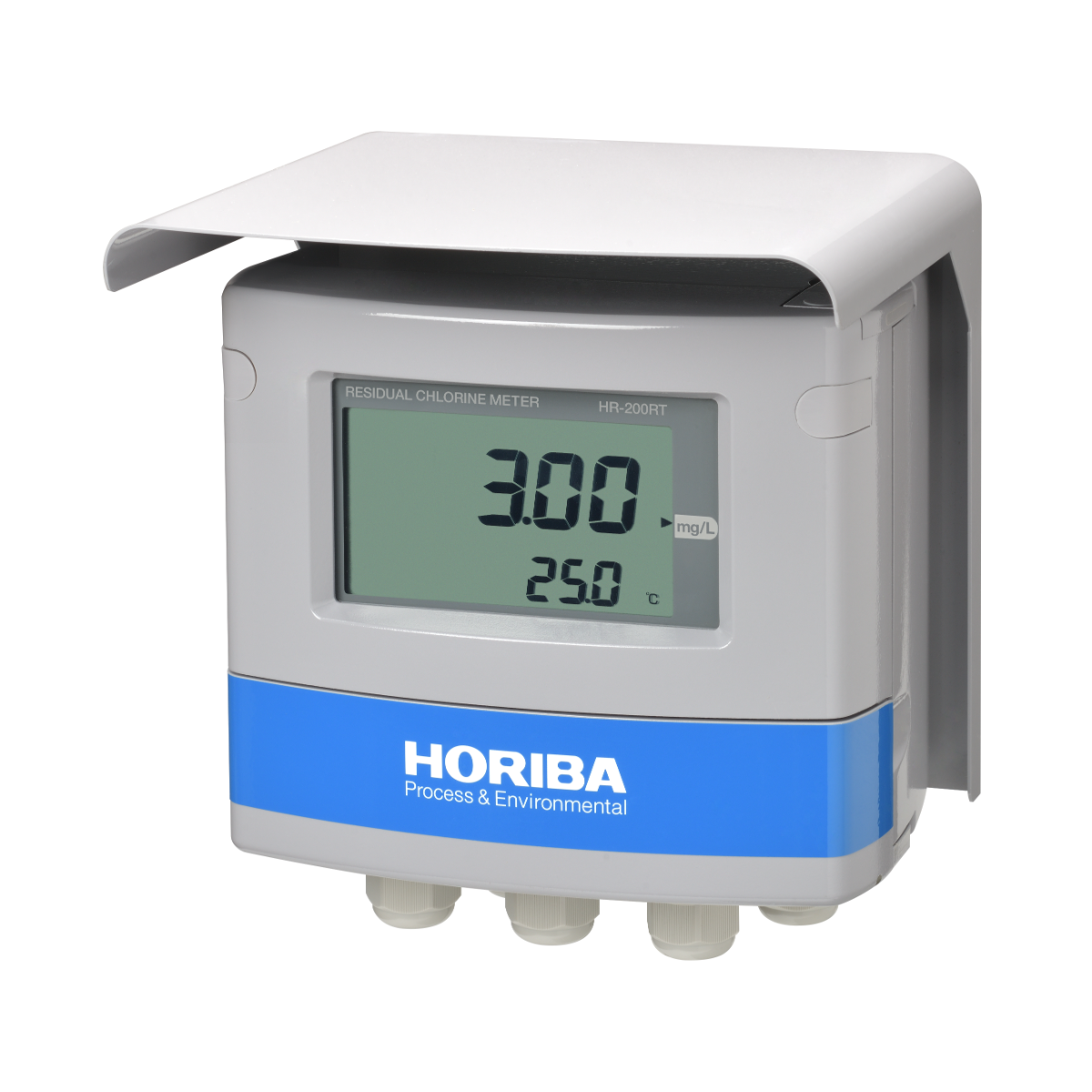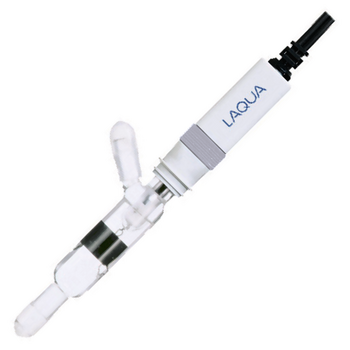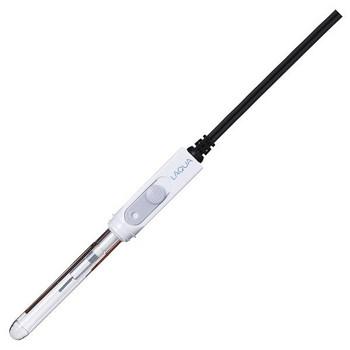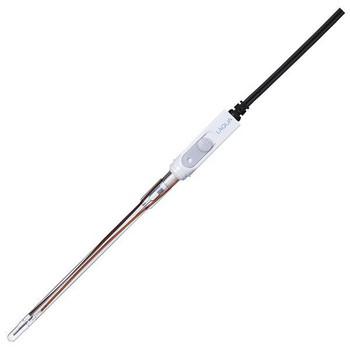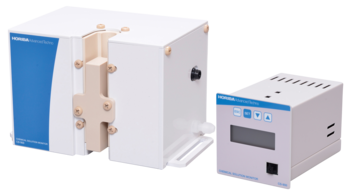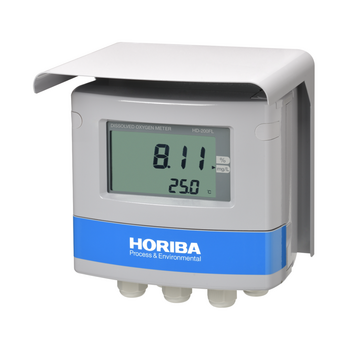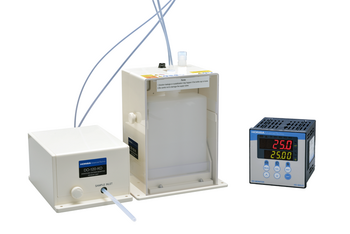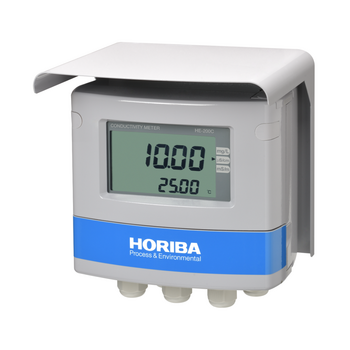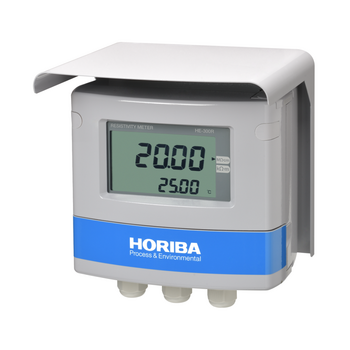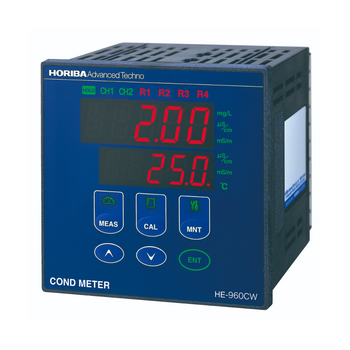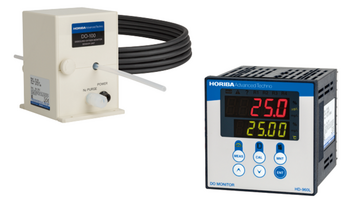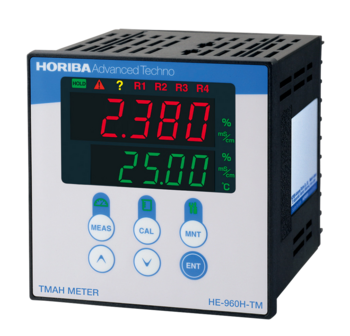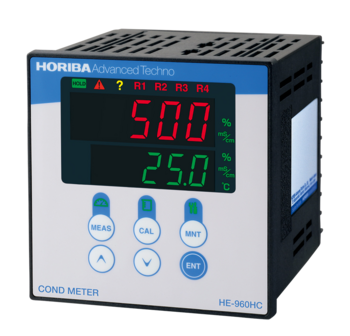Converter
| Product name | Residual Chlorine Monitor | ||
|---|---|---|---|
| Model | HR-200RT | ||
| Sensor type | RA-30 | ||
| Measurement range | Concentration | 0 mg/L to 3 mg/L (Display range: 0 mg/L to 5 mg/L) | |
| Temperature | 0℃ to 50℃ (Display range: -10℃ to 110℃) | ||
| Display resolution | Concentration | 0.01 mg/L | |
| Temperature | 0.1℃ | ||
| Performance | Concentration | Repeatability | Within ±0.05 mg/L (Equivalent input) |
| Linearity | Within ±0.05 mg/L (Equivalent input) | ||
| Temperature | Repeatability | ±0.5℃ (Equivalent input) | |
| Linearity | ±0.5℃ (Equivalent input) | ||
| Transmission output | Number of current outputs | 2 (Negative terminals of each transmission output channel are connected inside and thus have the same electrical potential) | |
| Output type | 4 mA to 20 mA DC, input/output isolated type | ||
| Load resistance | 900 Ω (Max.) | ||
| Linearity | Within ±0.08 mA (limited to the current linearity) | ||
| Repeatability | Within ±0.02 mA (limited to the current repeatability) | ||
| Output range | Output 1 | Residual chlorine concentration: An arbitrary value can be set within the range from 0 mg/L to 5 mg/L | |
| Output 2 | Temperature: An arbitrary temperature can be set within the range from -10℃ and 110℃ | ||
| Error output | Provided with burnout function (3.8 mA or 21 mA) | ||
| Hold function | Selectable from between the latest value hold and the preset value hold | ||
| Contact output | Number of current outputs | 4 | |
| Output type | No-voltage output contact | ||
| Contact type | Relay contact, R1 to R3: SPST (1a), FAIL: SPDT (1c) | ||
| Output capacity | R1, R2, FAIL: 250 V AC 3 A/30 V DC 3 A (resistance load) R3: 30 V DC 1 A (resistance load) | ||
| Contact function | R1, R2, R3 | Selectable from among the upper limit alarm, lower limit alarm, ON/ OFF control, during transmission output hold, and during calibration (closed at alarm operation, open under normal conditions and in a power-OFF state) | |
| FAIL | Error alarm (closed under normal conditions, open in an error or power-OFF state) | ||
| Description of alarm operation |
| ||
| Description of control operation |
| ||
| Contact input | Number of input points | 2 | |
| Contact type | Open collector no-voltage “a” contact | ||
| Condition | ON resistance: 100Ω (max.) Open-circuit voltage: 24 V DC Short-circuit current: 12 mA DC (max.) | ||
| Contact function | Selectable from among the external input for transmission output hold, flow switch input for interlock (open when the flow rate drops), and calibration command | ||
| Communicati on function | type | RS-485 | |
| Number of circuits | 1 | ||
| Signal form | Two wire type, the power source of the communication is isolated from the power of measurement circuit (the power source of transmission and communication are not isolated). | ||
| pH correction | Type | Connected with expansion connector | |
| pH correction range | 5.8 pH to 8.6 pH | ||
| Temperature compensation | Applicable temperature element | Pt1000: 1 kΩ (0℃) (embedded in the detector unit) | |
| Compensation range | 0℃ to 50℃ | ||
| Calibration function | One point calibration compared with reference temperature range | ||
| Calibration | Calibration method | Zero calibration (with zero water) Span calibration (comparative calibration with the value measured with the DPD method including electrical zero calibration) | |
| Additional function | Calibration log (number of days elapsed since the zero or last calibration), calibration error automatic judgment (zero) | ||
| Calibration control output (ZERO CAL) | Number of contact output | 1 | |
| Output type | Voltage contact output (connected power source voltage output) | ||
| Contact capacity | 250 V AC 0.5 A | ||
| Calibration cycle setting | 1 hour to 999 hour | ||
| CALR1 | Contact type | Relay contact, SPST (1a) | |
| Contact function | Zero water switching driven by solenoid valve | ||
| Self-check | Calibration error | Zero calibration error, outside the temperature calibration range | |
| Temperature sensor diagnosis | Temperature sensor short-circuit, temperature sensor disconnection | ||
| Converter error | CPU abnormality, ADC abnormality, memory abnormality | ||
| Operating temperature range | -20℃ to 55℃ (without freezing) | ||
| Operating humidity range | Relative humidity: 5% to 90% (no condensation) | ||
| Storage temperature | -25℃ to 65℃ | ||
| Power supply | Rated power supply voltage | 100 V to 240 V AC ±10% 50/60 Hz | |
| Power consumption | 35 VA (max.) | ||
| Others | With built-in power switch for maintenance | ||
| Structure | Installation | Outdoor installation type | |
| Installation method | Pole-mounted or wall-mounted | ||
| Protection class | IP65 | ||
| Material of case | Aluminum alloy (coated with epoxy-modified melamine resin) | ||
| Material of mounting brackets | SUS304 | ||
| Material of sun shade hood | SUS304 (coated with epoxy-modified melamine resin) | ||
| Material of display window | Polycarbonate | ||
| Display element | Reflective monochrome LCD | ||
| External dimensions | 180 (W) mm × 155 (H) mm × 115 (D) mm (excluding brackets) | ||
| Mass | Main frame: approx. 3.5 kg, Hood, bracket: approx. 1 kg | ||
Note
Although an arrestor (400 V discharge starting voltage) is mounted for the transmission output, contact input, and communication, install an optimum surge absorber element on the connection line, depending on the surrounding environment, device installation conditions, and externally connected devices.
Detector and measuring cell
| Product name | Rotating electrode polarographic residual chlorine sensor | |
|---|---|---|
| Model | RA-30 | |
| Measurement method | Rotating electrode polarographic method | |
| Measurement target | Free residual chlorine in sample water | |
| Measurement range | 0 mg/L to 3.00 mg/L | |
| Temperature compensation | Automatic temperature compensation using Pt1000 | |
| Performance | Linearity | Within ±5% full-scale range |
| Repeatability | Within ±2% full-scale range or ±0.05 mg/L, whichever is larger | |
| Response time | Within 120 s from the inlet of the measuring cell (90% response) | |
| Zero drift | Within ±1% full-scale range/month | |
| Span drift | Within ±10% full-scale range/month | |
| Sample condition*6 | Temperature | 0℃ to 45℃ |
| Flow rate | Measuring cell flow rate: 0.1 L/min to 0.5 L/min*1 | |
| Primary pressure | 0.01 MPa to 0.15 MPa*2 | |
| pH value | 5.8 pH to 8.6 pH (with no fluctuation over 1.0 pH)*3 | |
| Electrical conductivity | 8 mS/m or more*4 | |
| Calibration | Zero calibration | Zero water calibration, electrical zero calibration |
| Span calibration | Comparative calibration with the value measured with the DPD method (including electrical zero calibration) | |
| Material of liquid contact section | Electrode | Au, AgCI |
| Beads | Ceramic beads | |
| Filter | Nylon | |
| Other | PVC, PPO, PTFE, EPDM, Q | |
| Piping connection | sample inlet | φ6 mm × φ8 mm tube or Rc1/8 |
| sample outlet | VP16 | |
| Cleaning method | Physical cleaning with beads | |
| Cable length | Provided standard cable: 1.5 m, max. extension distance: 10 m | |
| Operating temperature range | 0℃ to 45℃*5 | |
| Operating humidity range | Relative humidity: 5% to 90% (no condensation) | |
| Storage temperature | 0℃ to 45℃ | |
| Structure | Installation method | 50 A pole-mounted or wall-mounted |
| Protection class | IP53 | |
| External dimensions | 110 (W) mm × 340 (H) mm × 110 (D) mm (excluding brackets) | |
| Mass | Approx. 1.5 kg | |
| Standard accessories | Beads, abrasive paper, mesh filter (2 types), O-ring | |
1: If use our designated flow switch (RA-FS30), regulate flow rate in 0.3 L/min to 0.5 L/min.
2: The measurement section is under an open air environment.
3: If pH of the measured sample varies, the value of residual chlorine also varies. Perform measurement in an environment in which pH variations are less likely to occur.
4: Measurement cannot be performed correctly when the electrical conductivity falls below 8 mS/m (80 μS/cm). Be sure to perform measurement in this conditions.
5: If the electrode is exposed to the direct sunlight, the anode and cathode electrode could deteriorate. Install the instrument where it is not exposed to direct sunlight (indoors).
6: If a reducing agent or oxidizer exists in a sample, it affects the reading. Do not use a sample containing a reducing agent such as thiosulfate or sulfite, or oxidizer such as O3, hydrogen sulfide or chlorine dioxide, as measurement cannot be performed correctly.
